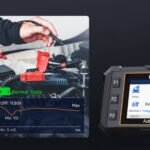Experiencing issues with your 1998 Toyota Tercel’s airbag system can be concerning. If you’re seeing 18 flashes from your airbag warning light, it’s crucial to understand what this signal means and how to address it. This guide provides information to help you diagnose potential problems related to “18 flashes” in your 1998 Toyota Tercel’s On-Board Diagnostics II (OBD2) system.
Before attempting any diagnostics or repairs on your airbag system, it’s vital to prioritize safety. The Supplemental Restraint System (SRS), including airbags, contains a backup power source that can remain active for a short period even after the car battery is disconnected. Incorrect handling can lead to accidental airbag deployment and injury.
Safety First: Disarming the Airbag System
Whenever you work on or around the airbag system, you must disarm it to prevent accidental deployment. Follow these steps carefully:
- Turn the ignition switch to the “LOCK” position and remove the key.
- Disconnect the negative (-) terminal cable from the car battery.
- Crucially, wait at least 90 seconds before proceeding with any work. This waiting period allows the backup power source in the SRS to discharge completely.
Important Cautions:
- Timing is critical: Always wait the full 90 seconds after disconnecting the battery before starting work.
- Memory Loss: Disconnecting the battery will erase the memory of your clock and audio system. Make a note of your radio presets beforehand.
- No Backup Power: Never use an external backup power supply while working on the SRS, as this can interfere with the system and cause unexpected deployment.
- Sensor Safety: If repairs might involve shocks or impacts near airbag sensors, remove the sensors beforehand to prevent damage.
- Heat Sensitivity: Keep airbag system components like the steering wheel pad, passenger airbag assembly, and sensors away from direct hot air or flames.
Re-arming the Airbag System After Service
Once you have completed your diagnostic or repair work, follow these steps to re-arm the airbag system:
- Ensure the ignition is in the “LOCK” position.
- Reconnect the negative (-) terminal cable to the car battery.
- Wait at least 10 seconds before turning the ignition key.
- Turn the ignition to the “ACC” or “ON” position.
- Observe the SRS warning lamp on your dashboard. It should light up and then turn off after approximately 6 seconds.
- If the SRS lamp remains lit or flashes, it indicates a persistent issue within the SRS system. Further diagnosis is required.
Understanding “18 Flashes” and Potential Diagnostic Trouble Codes (DTCs)
While “18 flashes” is not a standard OBD2 code, flashing patterns of the airbag warning light in older Toyota models can be interpreted as diagnostic signals. In the context of a 1998 Toyota Tercel, 18 flashes might indicate a specific issue within the airbag system, potentially related to a sensor malfunction or circuit problem.
It’s important to use an OBD2 scanner to retrieve the actual Diagnostic Trouble Codes (DTCs) stored in your car’s computer. These DTCs will provide a more precise indication of the problem. While “18 flashes” might be a general symptom, the OBD2 code will pinpoint the specific component or circuit that is malfunctioning.
A DTC like 31 – AIRBAG SENSOR ASSEMBLY MALFUNCTION from older Toyota systems could be related to issues that might manifest as “18 flashes”. The airbag sensor assembly is a critical component. It contains:
- Airbag Sensor: Detects rapid deceleration indicative of a collision.
- Safing Sensor: Acts as a secondary confirmation for airbag deployment.
- Drive Circuit: Triggers the airbag inflator.
- Diagnosis Circuit: Monitors the system for faults and stores DTCs.
- Ignition Control: Manages the airbag deployment sequence.
DTC 31 (or a similar code indicated by “18 flashes”) is recorded when the diagnostic system detects a malfunction within the airbag sensor assembly itself or its related circuits.
Alt text: Diagram of the 1996 Toyota Tercel Airbag System Circuit Layout.
Troubleshooting Steps for Airbag System Issues (Potentially Related to “18 Flashes”)
- Retrieve OBD2 Codes: Use an OBD2 scanner to read the stored DTCs. This is the first and most crucial step. Note down all codes present.
- Consult a Repair Manual: Refer to a repair manual specific to your 1998 Toyota Tercel. This manual will provide detailed information about interpreting OBD2 codes related to the SRS system and troubleshooting procedures.
- Inspect Sensor Connections: Carefully check the wiring and connectors leading to the airbag sensor assembly and other airbag system components. Look for loose connections, corrosion, or damage.
Alt text: Illustration of the location of Airbag System Components in a 1996 Toyota Tercel.
- Check Sensor Mounting: Ensure the airbag sensor assembly is securely mounted. Loose mounting can sometimes cause false readings.
- Professional Diagnosis: Airbag systems are complex and safety-critical. If you are not comfortable working on this system, or if you are unable to pinpoint the problem after initial checks, it is highly recommended to seek professional diagnosis and repair from a qualified mechanic specializing in automotive electronics and SRS systems.
Alt text: Wiring diagram showing the electrical connections within the 1996 Toyota Tercel SRS system.
Conclusion
Seeing 18 flashes on your 1998 Toyota Tercel’s airbag warning light is a signal that your SRS system has detected a potential fault. While “18 flashes” itself might not be a standard OBD2 code, it likely points to an underlying issue that needs attention. Using an OBD2 scanner to retrieve the specific DTCs is essential for accurate diagnosis. Always prioritize safety when working with airbag systems and do not hesitate to seek professional help to ensure proper and safe repair of your 1998 Toyota Tercel’s SRS. Remember, a properly functioning airbag system is critical for your safety and the safety of your passengers.
